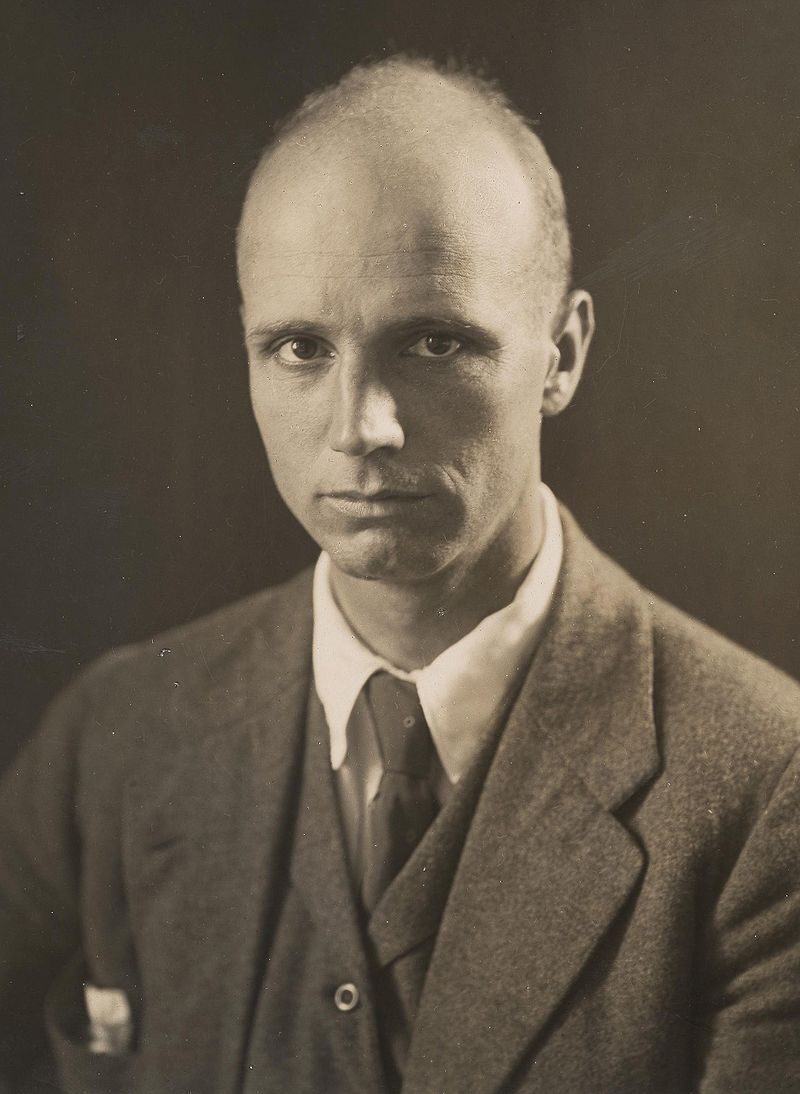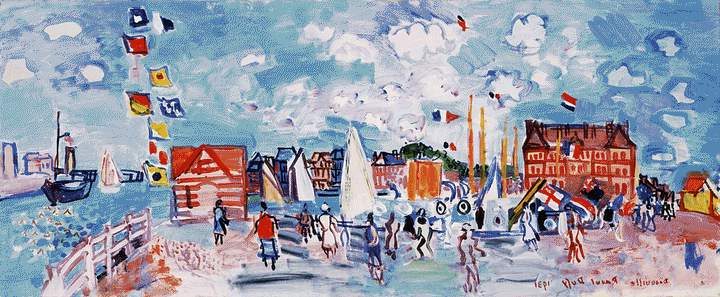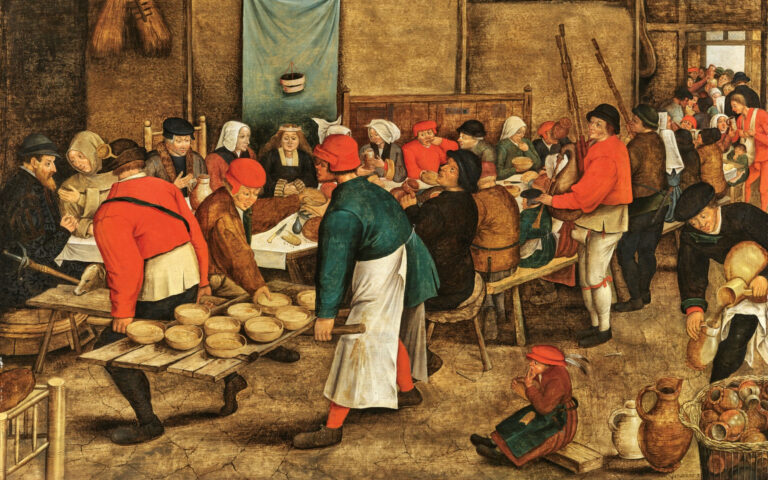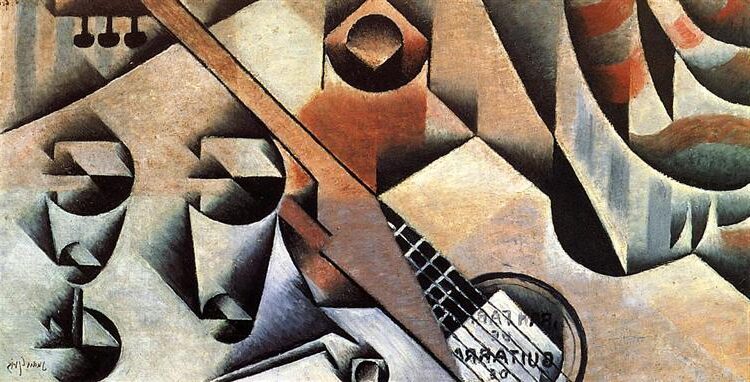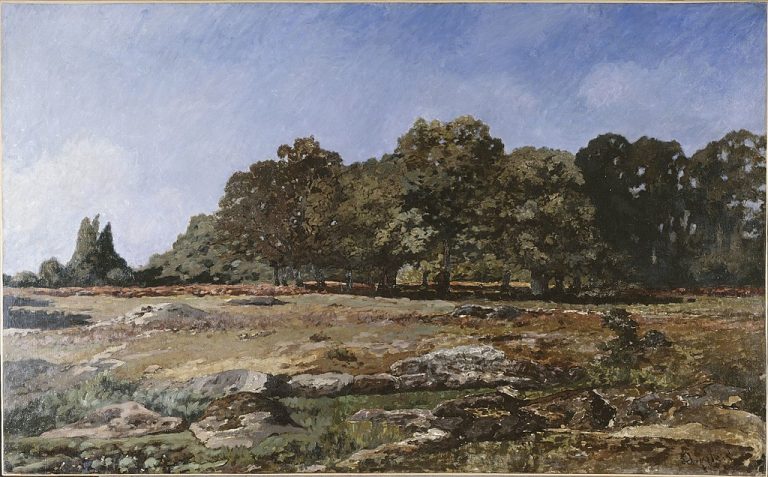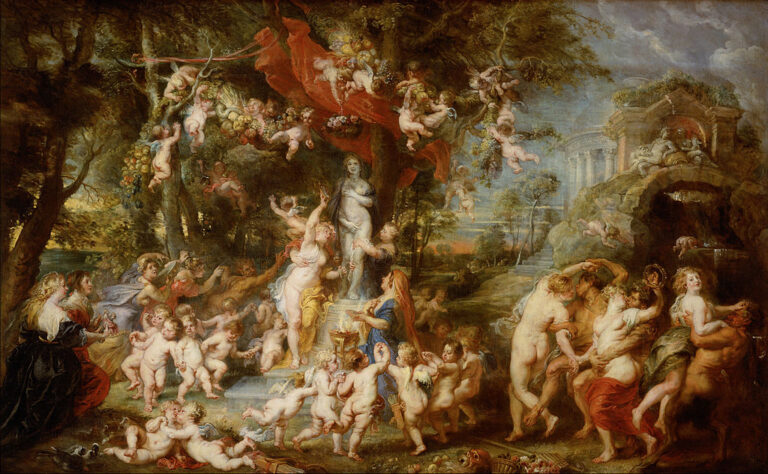Rockwell Kent Painter: A Master of American Expression in the 20th Century
Born: June 21, 1882, Tarrytown, New York, US
Death: March 13, 1971, Plattsburgh, New York, US
Art Movement: Modernism, Regionalism
Nationalité : Américain
Teachers: Arthur Wesley Dow, William Merritt Chase, and Abbott Handerson Thayer
Institution: Art Students League, Shinnecock Hills Summer School of Art, and New York School of Art
Rockwell Kent Painter: A Master of American Expression in the 20th Century
Life and Career of Rockwell Kent
Rockwell Kent lived a multifaceted life as an artist, writer, and adventurer. His journeys to remote wilderness areas deeply influenced his distinctive artistic style, which combined modernist techniques with traditional representation.
Vie et éducation précoces
Rockwell Kent was born on June 21, 1882, in Tarrytown, New York. His early interest in art was encouraged by his family, particularly after his father’s death when Kent was only five years old.
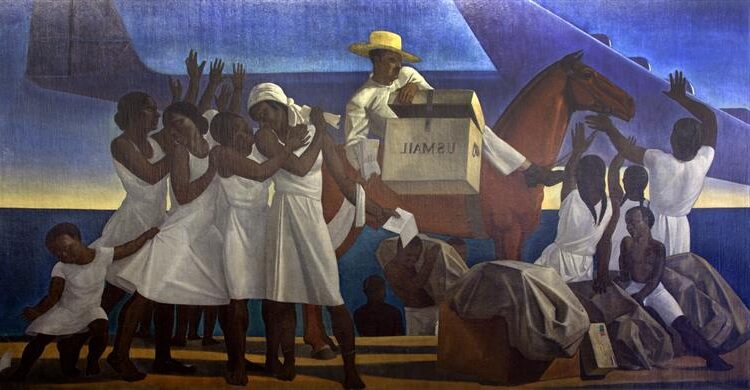
Mail Service in the Tropics, by Rockwell Kent
Kent received formal training at several prestigious institutions. He studied architecture at Columbia University but later shifted his focus to painting.
His art education continued under renowned painters William Merritt Chase and Robert Henri, who influenced his early artistic development.
During these formative years, Kent developed both technical skills and a philosophical outlook that would guide his career. His education instilled in him a strong appreciation for craftsmanship and a belief in art’s social purpose.
Artistic Evolution and Greenland Expeditions
Kent’s artistic style evolved significantly through his travels. His voyages to wilderness areas became central to his identity as an artist and heavily influenced his work.
One of Kent’s most significant journeys was to Greenland, where he made three extended visits. These expeditions produced some of his most iconic paintings, featuring stark landscapes with dramatic lighting and simplified forms.
His Greenland works often depicted human figures in harmony with powerful natural environments.
Kent’s printmaking also flourished during this period. His wood engravings and lithographs gained widespread recognition for their bold simplicity and emotional depth.
These prints appeared in popular books and magazines, bringing his distinctive style to wider audiences.
His travel writings, including “Wilderness: A Journal of Quiet Adventure in Alaska,” complemented his visual art and established him as a multifaceted creative figure.
Political Activism and International Recognition
Kent’s political views became increasingly progressive throughout his career. He actively supported labor movements and advocated for social justice causes through both his art and public activities.
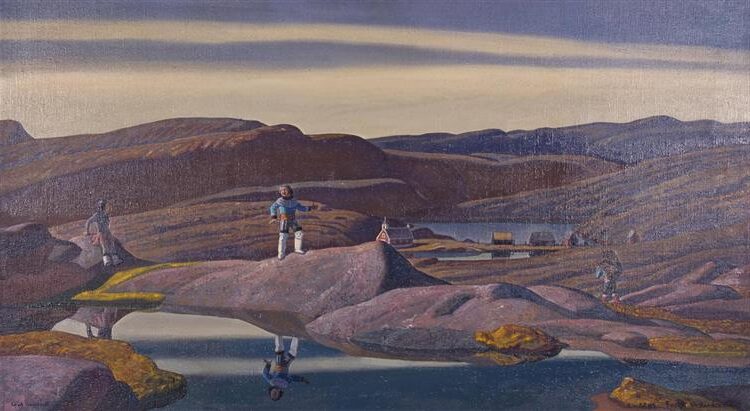
Tassiusak, Greenland, 1933, by Rockwell Kent
During the Cold War era, Kent’s leftist politics created significant controversy. His sympathies with the Soviet Union led to government scrutiny and affected his standing in the American art world.
Despite domestic criticism, Kent received the Lenin Peace Prize in 1967, demonstrating his international recognition.
Kent’s work found particular appreciation in the Soviet Union, where his art was celebrated for its humanistic qualities and depictions of working people. His political convictions were inseparable from his artistic vision, as he believed art should serve humanity and promote social progress.
Les dernières années et la mort
In his later life, Kent settled permanently at Asgaard Farm in New York’s Adirondack Mountains. This rural setting provided both inspiration and solitude for his continued artistic work.
Kent remained productive well into his senior years. His memoir “It’s Me O Lord” was published in 1955, offering insights into his artistic philosophy and personal experiences.
During this period, his work received renewed critical attention, though political controversies continued to affect his American reception.
Rockwell Kent died on March 13, 1971, at age 88. His legacy includes an impressive body of paintings, prints, illustrations, and writings that capture the grandeur of wilderness landscapes and express his humanistic ideals. His work continues to be recognized for its distinctive style and powerful expression of human connection to nature.
Œuvres artistiques et style
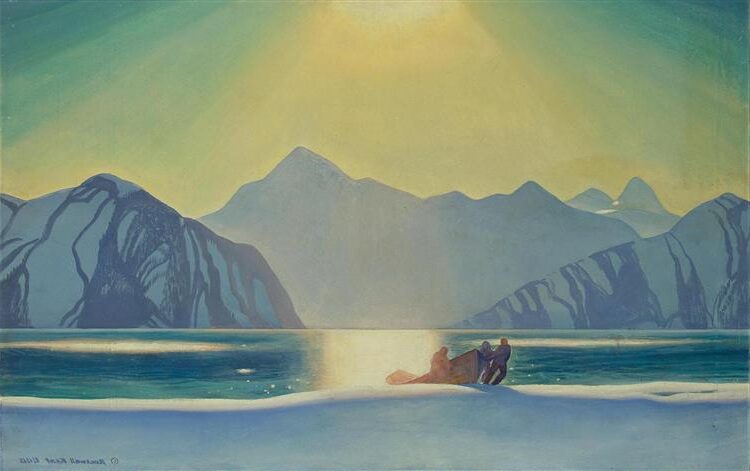
Sunglare, Alaska, 1919, by Rockwell Kent
Rockwell Kent’s creative output spanned multiple disciplines with a distinctive style characterized by strong lines, des compositions audacieuses, and a deep le lien avec la nature. His work often captured remote wilderness locations and conveyed a sense of spiritual connection to the landscape.
Peintures et illustrations
Kent’s landscape paintings feature stark, powerful imagery of wilderness areas from Alaska to Tierra del Fuego. His time on Monhegan Island in Maine profoundly influenced his artistic development, where he created dramatic seascapes with bold color contrasts.
“Winter in the Berkshires” exemplifies his ability to capture the serene yet powerful essence of nature using simplified forms and strong compositional elements.
Kent’s paintings often depict tiny human figures against vast natural backdrops, highlighting themes of human resilience and nature’s grandeur.
His illustration work brought him widespread recognition. Most famously, Kent created the powerful black and white illustrations for a 1930 edition of Herman Melville’s “Moby Dick,” which art historians consider among the finest book illustrations of the 20th century.
Printmaking and Wood Engraving
Kent mastered the technique of wood engraving, creating striking black and white prints characterized by bold contrast and meticulous detail. His printmaking style featured clean lines and dramatic compositions that captured both the beauty and harshness of remote landscapes.
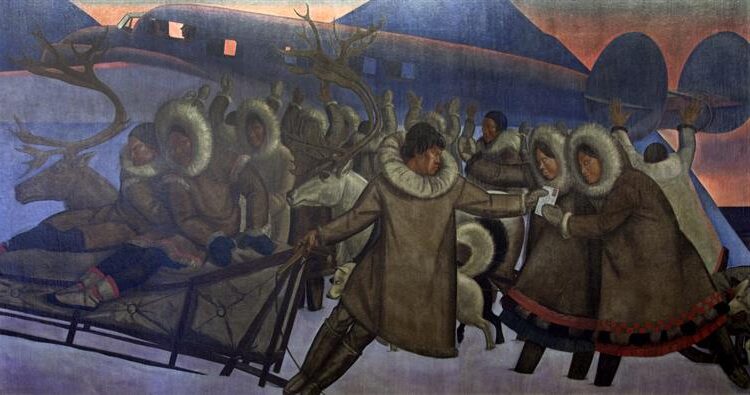
Mail Service in the Arctic, 1937, by Rockwell Kent
Many of Kent’s prints depict everyday people working and living in harmony with nature. These works emphasize shared humanity and often contain symbolic elements reflecting his political and social values.
His printmaking techniques involved careful planning and precise execution. Kent would create detailed preliminary drawings before transferring them to wood blocks for engraving.
His signature style in prints uses stark contrasts between black and white to create dramatic visual impact.
Kent’s prints became widely collected and helped make his artistic vision accessible to a broader audience beyond the fine art world.
Contributions littéraires
Kent was not only a visual artist but also an accomplished writer. His travel memoir “N by E” (1930) documents his sailing voyage to Greenland, combining his written observations with powerful illustrations that complement the text.
His writings reveal his deep connection to the natural world and interest in remote cultures. Kent’s literary style mirrors his visual work—clear, direct, and evocative. His books blend personal experience with philosophical reflection.
Kent also published “Wilderness: A Journal of Quiet Adventure in Alaska” (1920), documenting his time living on Fox Island. These literary works established him as a multifaceted creative figure whose writing and art reinforced each other.
Architectural Ventures
Before focusing exclusively on fine art, Kent studied architecture at Columbia University. This training influenced his artistic approach, particularly evident in the strong structural elements and precise compositions of his paintings and prints.
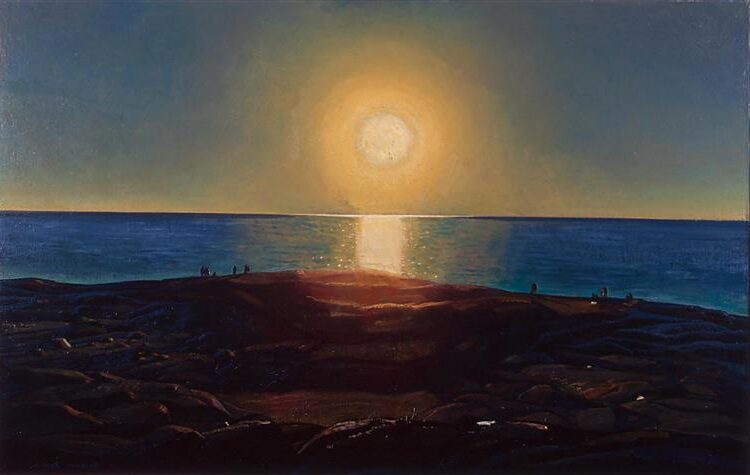
Calm and Free (Maine Coast), 1909, by Rockwell Kent
His architectural background manifested in the geometric precision of his compositions. Kent’s understanding of form and space helped him create landscapes with solid, almost sculptural qualities.
Though he didn’t pursue architecture professionally, Kent occasionally designed buildings, including his own home “Asgaard Farm” in New York. These designs reflected his appreciation for functional simplicity and harmony with natural surroundings.
Héritage et influence
Rockwell Kent’s artistic vision continues to resonate in museums worldwide. His distinct style and philosophical approach to art established him as one of the most influential American painters and illustrators of the early 20th century.
Rockwell Kent Collection and Exhibitions
The Plattsburgh State Art Museum houses the largest Rockwell Kent Collection, featuring over 5,000 works including paintings, drawings, and prints. This comprehensive collection showcases Kent’s diverse artistic talents and has become a vital resource for scholars and art enthusiasts.
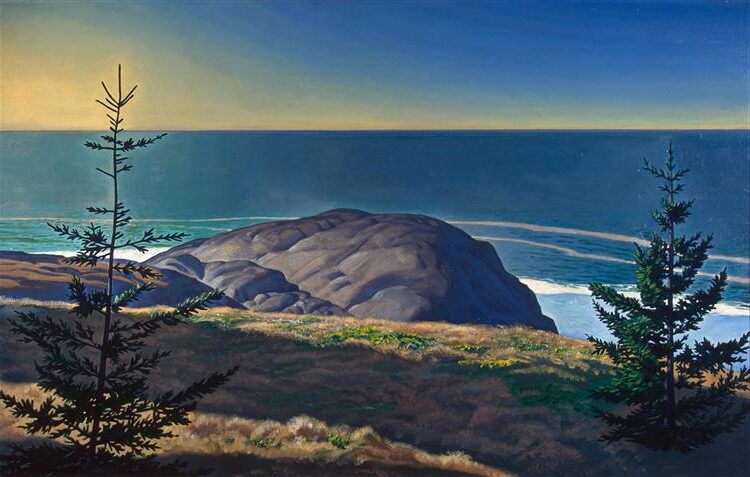
Young Spruces, Maine Coast, 1955, by Rockwell Kent
The National Gallery of Art in Washington, D.C. regularly displays Kent’s works, introducing new generations to his dramatic landscapes and powerful imagery. His art has also been featured in special exhibitions at the Philadelphia Museum of Art.
Russian museums hold significant Kent collections. In 1937, Kent donated 80 paintings to the Soviet Union, now displayed at The Pushkin State Museum of Fine Arts and The State Hermitage Museum.
Impact on Modern Art and Culture
Kent’s distinctive style—combining realism with symbolic elements—influenced numerous artists working in illustration and printmaking. His bold woodcut techniques and dramatic compositions created a visual language that many modern artists have adopted.
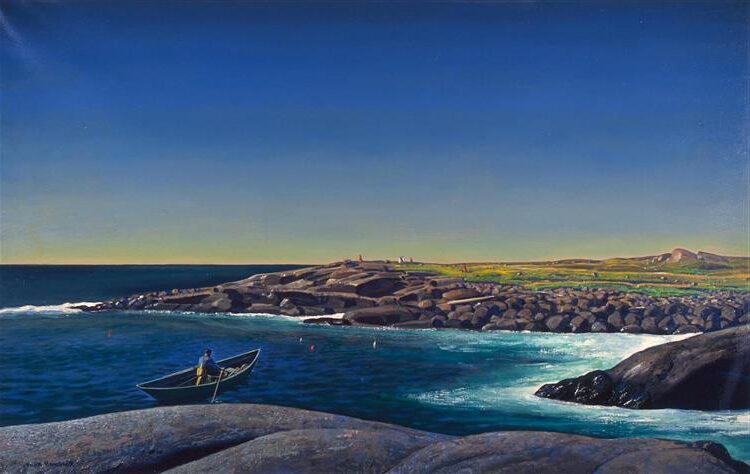
Maine Lobsterman, 1955, by Rockwell Kent
Beyond visual arts, Kent’s illustrations for literary classics like “Moby Dick” merged art with literature in ways that transformed book design. These illustrations remain among the most recognized versions of these texts.
Kent’s artwork often addressed social and political themes, establishing him as an artist with both aesthetic vision and cultural conscience. This combination of artistic excellence and social awareness continues to inspire contemporary artists.
His work remains protected by copyright but has been widely reproduced, ensuring his visual legacy extends beyond museum walls into popular culture.
Questions fréquemment posées
Rockwell Kent’s artistic legacy spans multiple mediums and subjects. His work continues to captivate art enthusiasts with its bold style and powerful imagery.
What are some of Rockwell Kent’s most famous paintings?
“Resurrection” (1927) stands as one of Kent’s most recognized works, featuring his distinctive bold lines and dramatic composition. The painting depicts figures rising from the earth against a stark landscape.
“November North Greenland” (1932-33) captures the austere beauty of Arctic landscapes with masterful use of light and shadow. This work exemplifies Kent’s fascination with remote, rugged environments.
“Azores” (1907) represents his earlier style, showing fishing boats with simplified forms and strong outlines. “Alaska Impression” (1919) demonstrates his ability to convey the grandeur of wilderness through simplified forms.
How did Rockwell Kent contribute to the art world through his woodcuts?
Kent revolutionized American printmaking with his distinctive black and white woodcuts. His precise technique featured strong contrasts and bold lines that created dramatic visual impact.
His illustrations for classic literature, including editions of “Moby Dick” and “The Canterbury Tales,” are considered masterpieces of book illustration. These woodcuts combined technical precision with emotional power.
Kent’s printmaking approach influenced generations of American artists through his balance of realism and stylization. His prints were accessible to middle-class Americans, helping democratize art ownership in the early 20th century.
What influence did Robert Henri have on Rockwell Kent’s style and technique?
Robert Henri, a leading figure of the Ashcan School, served as Kent’s mentor at the New York School of Art. Henri encouraged Kent to paint with emotional intensity and to find meaning in everyday subjects.
Henri’s emphasis on artistic independence shaped Kent’s willingness to pursue his own vision rather than follow trends. This guidance helped Kent develop his distinctive style combining realism with symbolic elements.
The social consciousness in Kent’s work reflects Henri’s belief that art should engage with contemporary life and issues. Kent’s bold brushwork and compositional strength also show Henri’s influence on his technical approach.
Are there any museums or galleries that feature a significant collection of Rockwell Kent’s works?
The Plattsburgh State Art Museum in New York houses the largest collection of Kent’s work, with over 5,000 pieces including paintings, prints, and correspondence. This comprehensive collection provides insight into his entire career.
The Farnsworth Art Museum in Rockland, Maine maintains an important collection of Kent’s paintings and prints. Kent’s connection to Maine makes this collection particularly significant.
The Smithsonian American Art Museum and the Metropolitan Museum of Art both feature notable works by Kent. The Philadelphia Museum of Art holds a significant collection of his book illustrations and prints.
Can you describe the themes and styles prevalent in Rockwell Kent’s Greenland series?
Kent’s Greenland paintings feature stark landscapes with dramatic lighting that emphasizes the harsh beauty of the Arctic. These works often depict vast expanses of ice and snow under dramatic skies.
Human figures in these compositions appear small against the immense natural backdrop, highlighting themes of human endurance and nature’s power. Kent’s color palette for these works typically uses cool blues and whites with dramatic contrasts.
The simplified forms and strong outlines in these paintings reflect Kent’s interest in combining realism with symbolic elements. His Greenland works convey both the physical reality and spiritual essence of the Arctic landscape.
What is the significance of Kent’s prints in the context of American art history?
Kent’s prints helped establish American printmaking as a major art form during the early 20th century. His work bridged fine art and commercial illustration, elevating both fields through his technical excellence.
His distinctive visual language influenced the development of American graphic design and illustration. Kent’s prints made fine art accessible to middle-class Americans through book illustrations and affordable reproductions.
Kent’s printmaking contributed to a uniquely American visual identity during a period of national artistic development. His work represents an important link between traditional printmaking techniques and modernist visual approaches.


